Welcome to our blog for the Plastic in the Pacific Crusade. If you missed the earlier editions please go to category file in the footer to go back and read them. They are listed under Plastic in the Pacific. Over the coming year we will be writing regularly of our adventures and what we are seeing. In this article we write about our last week in the Galapagos.
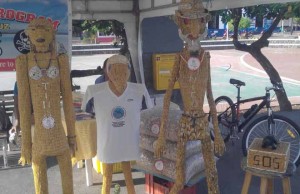 In part 1 of our Santa Cruz blogs, I left you as we had just met a very interesting person, someone who I would click with immediately, even though I couldn’t speak Spanish and he couldn’t speak English. I had just been ashore to top up the credit on our phone and as I was walking back to get the water taxi, at the end of the jetty where everybody who comes to the island must walk past, are three life size figures, one of a man, one of a lady and one of a bird. Not that unique until you realise they were made out of cigarette butts.
In part 1 of our Santa Cruz blogs, I left you as we had just met a very interesting person, someone who I would click with immediately, even though I couldn’t speak Spanish and he couldn’t speak English. I had just been ashore to top up the credit on our phone and as I was walking back to get the water taxi, at the end of the jetty where everybody who comes to the island must walk past, are three life size figures, one of a man, one of a lady and one of a bird. Not that unique until you realise they were made out of cigarette butts.
Miquel Andagana was the man I met and he runs a campaign known as the Nicotine Assassin. Every morning he walks the main streets of Santa Cruz here in the Galapagos and collects cigarette butts cast into the street, into gardens and some blatantly just dropped on the footpath. Over the last two years he has collected quite a few, just 661,000 odd. He says that each cigarette has the capacity to contaminate one cubic meter of water. With all the gutters of Santa Cruz leading to the ocean which we all come here to see, it is quite staggering to think that people would continue to discard their cigarette butts in such a careless manner. I asked him if he thought it was all tourists or if it was locals and he thought it was about 50/50 however Alice from Academy Bay Dive Center says a lot of locals don’t smoke.
What’s even more impressive about the campaign is that it is totally self-funded. Miquel has a book he sells for $10, which is about a fishing boat he was on that drifted at sea for 77 days, and t-shirts for $25. This is his only funding and after he has picked up the cigarettes for the day, he sets up his stand and is there all day, usually till about 7pm. He is doing a huge service to the community yet no funding from government. In fact most people call him the crazy nicotine man, which I could relate to as I was called the plastic bag boy a lot after my solo trip around Oz.
A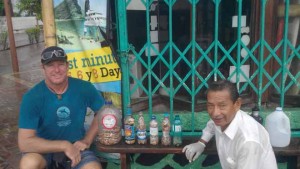 nnika and I decided to join Miquel for a morning and go and see for ourselves the extent of the issue. It was a miserable morning with misty rain as we met at 0600 at the jetty. Miquel already had a 5 liter bottle and had started collecting some already. Annika and I quickly found a couple of plastic drink bottles to use (easy to find on the ground) and we set about our task. The photo says it all really, we collected a lot of butts that morning. It was staggering to thing that Miquel had done the clean up the day prior and there were all of these butts back in the street, effectively a day of smoking. The main spots we seemed to find butts were out the front of hostels, in the parks and wherever people tended to sit and rest.
nnika and I decided to join Miquel for a morning and go and see for ourselves the extent of the issue. It was a miserable morning with misty rain as we met at 0600 at the jetty. Miquel already had a 5 liter bottle and had started collecting some already. Annika and I quickly found a couple of plastic drink bottles to use (easy to find on the ground) and we set about our task. The photo says it all really, we collected a lot of butts that morning. It was staggering to thing that Miquel had done the clean up the day prior and there were all of these butts back in the street, effectively a day of smoking. The main spots we seemed to find butts were out the front of hostels, in the parks and wherever people tended to sit and rest.
Apart from the cigarette butts, the amount of small plastics on the streets was incredible. We didn’t clean up the plastics as we’d need a truck to follow us in order to do it. At first glance you think the place is fairly clean, but it really isn’t. It was a huge eye opener and one that made us feel a little bit sad. It really makes you question what people are thinking these days. We came here to the Galapagos to see a pristine environment with amazing wildlife and here we have a typical modern society, ever reliant on plastics and not really working out how to dispose of it properly. Our philosophy of prevention being better than a sure rang through once again. We need to stop using plastics and find alternatives. Check out our article on Miquel Nicotine Assassin program at http://www.oceancrusaders.org/nicotine–assassin
As we were waiting for parts to arrive from mainland USA, we had a bit of time to kill. We would run out of water and even when we tried to pump water into the watermaker using an external pump, for some reason it would not work, so we had to get some delivered out to us. This cost us US$70. This was made up of 50 cents per gallon and then a $10 delivery fee. Expensive mistake to not have a spare impeller and it would get worse. More on that later.
We’d also need to fuel up. I had read that the foreigner price of diesel is around $6 per gallon. You have to organize it through your agent, you can’t just go to the service station and get it yourself, this is actually illegal. So we called Javier and he said it would be around $3 a gallon, which we were stoked at. We had it delivered out and the price was actually $3.53 a gallon and a $10 permit fee. We also had two gas bottles filled at $5 per kilogram. And for the delivery and service we paid $20. So it wasn’t too bad, however on mainland Ecuador you pay $1.03 per gallon I am told.
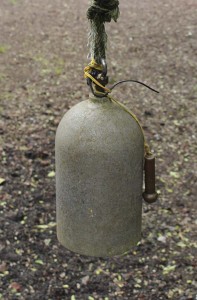 Through Alice at Academy Bay Dive Center, we were introduced to Jill Peth who is a teacher at the Tomas de Berlanga School, another Australian on the island. We were invited up to speak with her class of 10/11 year olds about our campaign. This school is unique in that it is funded by parents who want their children to have a better than normal education with a particular focus on English as that will give the students access to better jobs in the tourism industry. So we caught a taxi up there for $3 and walked into the open staff room. There are no windows, not even mesh, it is just an open building amongst the trees. We had a quick tour of the grounds with the stand outs being the canteen that is called ‘The Bar’, the school bell is a cut in half dive tank and the rooms are all open, no glass.
Through Alice at Academy Bay Dive Center, we were introduced to Jill Peth who is a teacher at the Tomas de Berlanga School, another Australian on the island. We were invited up to speak with her class of 10/11 year olds about our campaign. This school is unique in that it is funded by parents who want their children to have a better than normal education with a particular focus on English as that will give the students access to better jobs in the tourism industry. So we caught a taxi up there for $3 and walked into the open staff room. There are no windows, not even mesh, it is just an open building amongst the trees. We had a quick tour of the grounds with the stand outs being the canteen that is called ‘The Bar’, the school bell is a cut in half dive tank and the rooms are all open, no glass.
The school year here runs till the start of February and goes back again in early April. This is because of the wet season. So for three days between Christmas and New Years the students are required to go to school, not what I’d call fun. However it wasn’t really learning this day, it was all about parties and the young children were having a great time eating lots of food and drinking plenty of juice. We got to our class and I had been told that these students were the movers and shakers of the future. Most had good English as their parents were tour guides or in politics. I presented the adult lesson to them. Usually for children this age I hold back a few of the images that are quite graphic but with these guys being smarter than the average 10 year old, I decided to risk it. And it paid off. The looks on their faces when I put up the beach covered in dead dolphins in Taiji, Japan, and told them that dolphin shows fund the senseless slaughter of 25,000 dolphins every year was exactly what I’d hoped for. The next thing one of the students says, ‘I will never go to SeaWorld…. ever!’. They knew quite a lot already, particularly about shark finning. Being close to their home, as boats were recently caught in the Galapagos finning sharks, they had a concept of what was going on. However the image of a whale shark washed up on a beach without fins and a hammerhead sinking to the bottom without fins brought another reaction that can only be good for the future. These are two creatures people come to the Galapagos to see. Killing tourist attractions seems illogical to them.
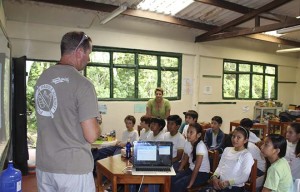 We teach to students as we know they will talk to their parents and are the future leaders. This presentation really hit home for a lot of the children and I hope that we have encouraged many of them to make a difference in the future. One of the things with this school is that they are not very well funded and are constantly looking for books and other items that schools so desperately need. Their computer room is full of old computers which could very well use an update. Their library is in need of lots of books, not novels we would read, educational books. In fact if you go to Amazon and put in Tomas De Berlanga school you should be able to find a way to donate a book to their cause. If you are cruising through the islands, then I ask that you bring something with you. A set of reusable cups would be great as they are using plastic cups at present, so to eradicate that waste would be good. Even a set of reusable plates would be good to avoid the paper plates they currently use. You are welcome to visit the school at any time, in fact large groups tour through there on a regular basis so it is something different to do when you come to Santa Cruz. Just drop in and see Alice at Academy Bay and she will put you in touch with Jill, or contact the school direct.
We teach to students as we know they will talk to their parents and are the future leaders. This presentation really hit home for a lot of the children and I hope that we have encouraged many of them to make a difference in the future. One of the things with this school is that they are not very well funded and are constantly looking for books and other items that schools so desperately need. Their computer room is full of old computers which could very well use an update. Their library is in need of lots of books, not novels we would read, educational books. In fact if you go to Amazon and put in Tomas De Berlanga school you should be able to find a way to donate a book to their cause. If you are cruising through the islands, then I ask that you bring something with you. A set of reusable cups would be great as they are using plastic cups at present, so to eradicate that waste would be good. Even a set of reusable plates would be good to avoid the paper plates they currently use. You are welcome to visit the school at any time, in fact large groups tour through there on a regular basis so it is something different to do when you come to Santa Cruz. Just drop in and see Alice at Academy Bay and she will put you in touch with Jill, or contact the school direct.
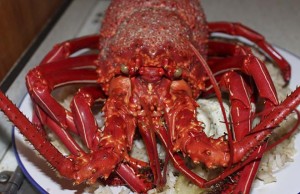 Christmas Eve came up and as Sweden celebrates Christmas on this day, and it was Christmas day in Australia, it felt like Christmas to us. So Annika went and got a couple of big lobsters from the fish market, which we would have for dinner. She actually got the smallest ones there but they were easily 1kg each, probably approaching 1.5. Lucky we have a big pot onboard, although we could barely fit one in at a time. It was an amazing meal that would fill us up a little too much, but that’s what Christmas is for, over eating and enjoying every minute of it.
Christmas Eve came up and as Sweden celebrates Christmas on this day, and it was Christmas day in Australia, it felt like Christmas to us. So Annika went and got a couple of big lobsters from the fish market, which we would have for dinner. She actually got the smallest ones there but they were easily 1kg each, probably approaching 1.5. Lucky we have a big pot onboard, although we could barely fit one in at a time. It was an amazing meal that would fill us up a little too much, but that’s what Christmas is for, over eating and enjoying every minute of it.
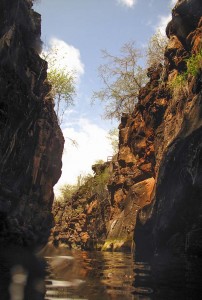 Christmas day was gorgeous, with no rain and mostly sunny. We had been told of a beach to go and explore on the ‘German’ side of the island. On the South Eastern side of the island, all the houses are apparently owned by Germans. We caught the boat over and walked along to the beach which was pretty ordinary. There were some stunning properties along the way but the beach was shallow with mirky waters and not too enticing. We had been told that we should go past the first beach and we started following the signs to Las Grietas thinking that was our destination. So we are somewhat surprised when we find this little gorge at the end of the path. So now knowing that Las Grietas is Spanish for ‘Cracks’ it makes a bit more sense. Maybe we hadn’t heard right as we expected a beach but here we were in this stunning little gorge, filled with water and plenty of people swimming. We had brought our snorkel gear as we’d been told it was really nice to swim at our destination. So in we jumped and found the water, well let’s say ‘refreshing’, no let’s call it as it was, it was cold. But it was clear and deep. The gorge was probably 10m wide at best and the cliffs rose easily above the water by 10-15m and into the water by another 6-7. The first section was probably 50m long and then you climb over a set of rocks into the second and it is shallow and short at about 20m. Then you swim under a rock into the final gorge and it is beautiful. The sunlight was streaming down one of the walls into the water and there were plenty of big mullet swimming, a few red grunters and then all over the rocks are these tiny little frog fish. We even saw two white spotted moray eels on our second visit 6 days later. The place is tidal with the water rising and falling with the ocean, although I couldn’t get the aspect of how this works as you seem a lot higher up than the ocean when you are up the top looking down from the lookouts. But the fish got in somehow.
Christmas day was gorgeous, with no rain and mostly sunny. We had been told of a beach to go and explore on the ‘German’ side of the island. On the South Eastern side of the island, all the houses are apparently owned by Germans. We caught the boat over and walked along to the beach which was pretty ordinary. There were some stunning properties along the way but the beach was shallow with mirky waters and not too enticing. We had been told that we should go past the first beach and we started following the signs to Las Grietas thinking that was our destination. So we are somewhat surprised when we find this little gorge at the end of the path. So now knowing that Las Grietas is Spanish for ‘Cracks’ it makes a bit more sense. Maybe we hadn’t heard right as we expected a beach but here we were in this stunning little gorge, filled with water and plenty of people swimming. We had brought our snorkel gear as we’d been told it was really nice to swim at our destination. So in we jumped and found the water, well let’s say ‘refreshing’, no let’s call it as it was, it was cold. But it was clear and deep. The gorge was probably 10m wide at best and the cliffs rose easily above the water by 10-15m and into the water by another 6-7. The first section was probably 50m long and then you climb over a set of rocks into the second and it is shallow and short at about 20m. Then you swim under a rock into the final gorge and it is beautiful. The sunlight was streaming down one of the walls into the water and there were plenty of big mullet swimming, a few red grunters and then all over the rocks are these tiny little frog fish. We even saw two white spotted moray eels on our second visit 6 days later. The place is tidal with the water rising and falling with the ocean, although I couldn’t get the aspect of how this works as you seem a lot higher up than the ocean when you are up the top looking down from the lookouts. But the fish got in somehow.
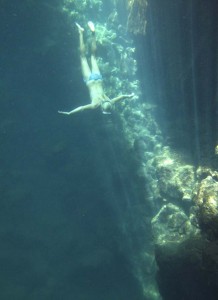 Between Christmas and New Years, we wouldn’t achieve a lot. We spent plenty of time relaxing, reading books and even watching a couple of movies on my computer. We of course ticked off a few jobs on our to do list as we kept our water consumption to a minimum. Our goods had arrived in Guayaquil on the mainland on the 23rd so we were hopeful of an arrival before New Years. However things move at glacial pace over there it seems and with all the holidays, they weren’t cleared until the 31st which meant we wouldn’t get them till the 4th.
Between Christmas and New Years, we wouldn’t achieve a lot. We spent plenty of time relaxing, reading books and even watching a couple of movies on my computer. We of course ticked off a few jobs on our to do list as we kept our water consumption to a minimum. Our goods had arrived in Guayaquil on the mainland on the 23rd so we were hopeful of an arrival before New Years. However things move at glacial pace over there it seems and with all the holidays, they weren’t cleared until the 31st which meant we wouldn’t get them till the 4th.
We had heard a lot about New Years here in the Galapagos. They have a few strange customs. The weeks leading into New Years, a lot of paper mache figurines start appearing all over the place. They are dressed up, some are cartoon characters, some are human like and it is all a bit strange. The custom is that on New Years Eve you carry around your figurine all day and then in the New Year, you burn it. Yep, clothes and all, just burnt. Another strange one is that guys dress up as girls and parade around all day, some with doll babies and all. Just before midnight, the best looking ‘Lady boy’ wins a prize.
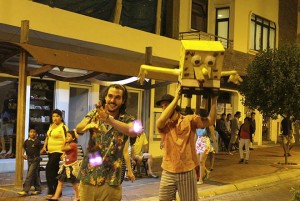 The set up on the main stage at the port was massive. The amount of speakers and lights mean there would be a serious party on that night. During the day, stands start popping up all the way up the street with big plastic tubs full of ice and beer and then more beer in crates behind the stand. Early in the evening we are sitting on the boat and it all seems quite civil so we make our in around 2200 and listen to the lady signing for a while before walking the street to take in the entire town atmosphere. With a population of 3,000 people and then tourists, I can pretty much safely say that the island was at the port. People were everywhere and everyone was having a great time. No one was drunk, it was really kid friendly and people just wanted to have a good time. At midnight they set off fireworks and then the bands played on till about 6 in the morning. Out on the boat, we could hear them but it wasn’t as bad as our first nights arrival, we were actually able to sleep.
The set up on the main stage at the port was massive. The amount of speakers and lights mean there would be a serious party on that night. During the day, stands start popping up all the way up the street with big plastic tubs full of ice and beer and then more beer in crates behind the stand. Early in the evening we are sitting on the boat and it all seems quite civil so we make our in around 2200 and listen to the lady signing for a while before walking the street to take in the entire town atmosphere. With a population of 3,000 people and then tourists, I can pretty much safely say that the island was at the port. People were everywhere and everyone was having a great time. No one was drunk, it was really kid friendly and people just wanted to have a good time. At midnight they set off fireworks and then the bands played on till about 6 in the morning. Out on the boat, we could hear them but it wasn’t as bad as our first nights arrival, we were actually able to sleep.
With the parts not arriving till the 4th we ordered another round of water, which was hard to take. Spending money on water is really crazy, especially when it’s another US$70 to fill our tanks. All they do here to make the water from the tap drinkable is filter it once more. The saying that 40% of bottled water is tap water is so true. We could take normal water as we had filters on the boat, however we had no choice. However on the day of the due delivery of water, we get a message that our parts were arriving that afternoon (Saturday 2nd). So we cancelled the water and waited for our goods. They wouldn’t get to us until 5pm so we spent the morning up at the markets getting fresh food for our transit to Marquesas, I cleaned all the slime off the hull once again and we took another walk out to Tortuga Bay to walk along the beach with the surf rolling in. If all went well, we would be out of there the day after so getting some miles in the legs would be a good thing. This time I didn’t overheat as it was cloudy.
So we get our parts along with a bill that shocks me totally. I had heard that parts in Ecuador are expensive but when you see a bill of $376 for parts that cost you $216, and have already paid a freight bill of $92, then you can’t fathom it. I find out that because West Marine sent the packages in two different boxes, that I paid two times the administration fees, so that was an additional $54 that I shouldn’t have had to pay. Then on one of them there is a ‘safe guard’ fee of $46. The item was only $99 in that package so I couldn’t understand this at all. The taxes and duties work out to be about 43% and then the agent had his own charges. So for three impellers, a Tahiti Flag, a USB socket and a BBQ mount, I would end up paying about US$700. Unbelievable but a lesson learnt and hopefully others will read this and learn from our mistake…..make sure you have spares for everything before you get to Ecuador.
So back on the boat I install the impeller. We have the same issue as with the external pump, it just isn’t pumping enough water. I check the filters and piping on the outlet side of the pump once again for impeller bits and find a few additional bits. I put it back together and still have the same issue. I pull the manifold apart to see if anything is in that and put it back together, still the same problem. I am getting frustrated and both Annika and I can’t believe we are having these issues. So we stop for dinner and whilst doing that I decide that I will pull the pump off. I remove the pump and as I am taking the inlet hose off, a heap of impeller bits fall out. I had never thought that the impeller bits would end up in the inlet instead of the pump. We put it back together and wouldn’t you know it, we are making water again. It was a 4 hour mission, but we now know a lot about our portable water maker.
The next morning we would fill our tanks, top up our fuel supply and ready ourselves for sea. We wanted to go on the Sunday but being a weekend, the authorities wanted to charge us double and they wouldn’t come until the afternoon so we decided to stick to a Monday morning departure. We did a bit of social stuff and then took a walk out to the Charles Darwin reserve to see the Land Tortoises once again and get a last big walk in. We would meet Javier at 0900 Monday morning. We would then pick up our stern line, using the high pressure hose to clean off all the growth. We would then heave the anchor, once again using the high pressure hose to clean off the growth, and then we would set sail for our longest passage to date, 3019nm to Marquesas. Our routing had an eta of 23 days later.
In our next edition we tell you the tale of our passage to the Marquesas. Would it go smoothly like the Atlantic, or did we have something different in store for us this time.
Ocean Crusaders are out to change the way people treat our oceans. Our online education program is free to download at www.OceanCrusaders.org/education where children can learn of the issues our oceans are facing and how they can make a difference. The Plastic in the Pacific Crusade is about educating the South Pacific Islands, finding out what is happening in these islands and updating our programs. You can join us in the Pacific and see for yourself what we do.
Ocean Crusaders Plastic in the Pacific Crusade is proudly supported by: Cressi Dive Gear, Gill Marine, Keen Footwear Australia, Barz Optics Sunglasses, Maxsea Navigation Software, Digital Diver Cairns, LED Dive Lights Australia, Boat Names Australia, Predictwind Weather & Sail-world.com
[cincopa A0AA8LNV2Pcy]
SIGN UP FOR OUR BLOGS